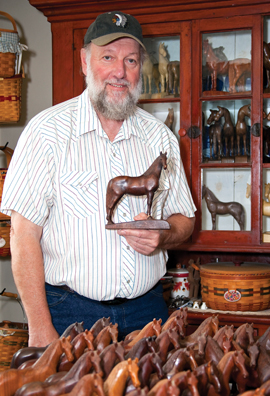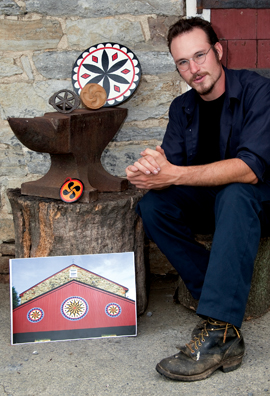A Passion For Collecting
By J.F. Pirro
A Horse Is A Horse
 It’s purely a coincidence that Ted Knieriem lives on Taylor Drive in Center Valley. His woodcarving idol, William G. Taylor, lived in nearby Upper Black Eddy, but a good proportion of his folk art carved wooden horses reside in an old Dutch cupboard at Knieriem’s.
It’s purely a coincidence that Ted Knieriem lives on Taylor Drive in Center Valley. His woodcarving idol, William G. Taylor, lived in nearby Upper Black Eddy, but a good proportion of his folk art carved wooden horses reside in an old Dutch cupboard at Knieriem’s.
There, they look out the 12 windowpanes as if they’re barn windows. “When they’re in there, they look pretty,” Knieriem says. “It keeps them out of the dust.”
When the local collector walks into an antique shop, he hears the whispers: “Here comes the horse man.” Knieriem says, “I have a lot of people looking for them, but they can’t find them. If you know someone who has one, they usually know someone who has one.”
Taylor, who died in 1975 at the age of 93, is believed to have carved 1,200 horses of two sizes: nine inches and seven inches tall. Knieriem has 46 of them, knows the whereabouts of 40 others in a 20-mile radius and continues searching for the rest. In a notebook, he keeps track of who had each horse in his collection, its history and the price he paid. Each is identified with a unique colored bead he ties with sinew to one of the horse’s legs. A heavy-stock blue card charts all those he’s still hunting.
After drilling a well for Taylor in 1966, he bought his first horse directly. A few years later, a friend sold him a Taylor horse he bought out of the back of Taylor’s trunk at a gas station. Knieriem would find them in antique shops and benefit from ads he placed. Today he’ll go a year without one, then net four in three different locations in one weekend. Or he’ll get calls, where the caller immediately says, “My horse is not for sale,” then asks its value. Knieriem doesn’t mind educating them.
Originals appraise at $75 to $100, but he’s paid a couple hundred dollars a piece. Sometimes adds one of his own Taylor-esque knock-off carved horses, making him a bit of a horse trader, too. “All I carve is horses,” Knieriem says. “All he carved was horses.”
Knieriem has carved 100 of his own, though not one has ever suited him and others have said they like his better than Taylor’s. Walnut is the primary wood for both men’s work, though Knieriem also uses poplar, and Taylor, basswood. Knieriem readily admits his are copies and doesn’t sell them to avoid confusion. He numbers, dates and signs his bases with a hot nail to carve TK. Taylor used a return address label and a branded WGT on the tapered, sloping base that rises to the horse’s front legs. Some aren’t signed, though still distinctive.
Taylor glued on his heads, and some of his bodies were carved in three pieces. Knieriem’s are all one piece. Taylor’s tails are thicker, but his legs thinner. Knieriem is after more of a farm horse look, harkening back to his grandfather’s Tunnel Farm in Perkasie, now home to the Pennridge Airport. “I always liked horses, but I used to be afraid of them,” he says.
The Barn Star Photographer
 Patrick J. Donmoyer isn’t the first to suggest that the persistent, diverse and colorful tradition of Pennsylvania folk art, which overlaps architectural tradition in the form of barn stars, parallels the Pennsylvania Dutch agricultural lifestyle and celestial observations, but he’s among the first to permanently document it.
Patrick J. Donmoyer isn’t the first to suggest that the persistent, diverse and colorful tradition of Pennsylvania folk art, which overlaps architectural tradition in the form of barn stars, parallels the Pennsylvania Dutch agricultural lifestyle and celestial observations, but he’s among the first to permanently document it.
While studying fine arts, printmaking and textiles and minoring in Pennsylvania German studies at Kutztown University, he first began informally photographing Pennsylvania Dutch barn stars in 2007. “Notice, I do not call them ‘hex signs,’” he says. A casual pastime became a primary preoccupation. By 2008, he received research funding to begin documenting Berks County’s barn stars. That summer, he systematically traveled every agricultural road in the county to photograph all publicly visible decorated barns. In Berks alone, Donmoyer found over 400. Where possible, he also photographed barn interiors — 19th century graffiti — which often take the same geometric forms as the exterior stars.
His reasoning twofold. First, the traditional art is rapidly vanishing from our landscape as barns are torn down or modernized. Second, too few properly understand the tradition, which is often explained away as purely decorative. While this is true, the stars have also become cultural emblems. Still, tourist literature inaccurately suggests the “Amish” created the “hex” to ward off witches. “This is simply not true,” Donmoyer says. “In the Pennsylvania Dutch dialect, there are only two words used for the designs, blumme (flowers) and schtanne (stars).”
Donmoyer, the historic building conservator at the Pennsylvania German Cultural Heritage Center on Kutztown University’s campus, is focused on using his thorough photographic collection to write a foundational work on Berks County stars and their cultural implications plus two follow-up volumes, one of Lehigh County stars and another on other local counties where the tradition isn’t as evident, including Northampton and Carbon.
All His Marbles
 Hansel de Sousa, an anesthesiologist from Nazareth, can hardly put his interest in marbles to sleep. An advanced collector, his jewels are prized commodities and routinely photographed models in books. “And I’m still hoarding,” he admits. “Just because I have one (particular) marble doesn’t mean I don’t need a case full.”
Hansel de Sousa, an anesthesiologist from Nazareth, can hardly put his interest in marbles to sleep. An advanced collector, his jewels are prized commodities and routinely photographed models in books. “And I’m still hoarding,” he admits. “Just because I have one (particular) marble doesn’t mean I don’t need a case full.”
His primary interest is American machine-made marbles in original boxes, but he also has rare sets of Victorian-era white porcelain marbles with black numbers called Magic Squares sets. He has Colonial-era marbles from the Henry Ford collection. There’s also a miniature set with a board for which the handmade marbles are smaller than pinheads.
As for marbles memorabilia, de Sousa has one of maybe 10 known original copper-coated cement trophies awarded to the National Marbles champion when the annual summer tournament was first played in Atlantic City, N.J. The now Internet-driven hobby has, for example, allowed him to amass a collection of 40-plus marble-themed pinbacks. But he admits he’s picky: “It takes hours and hours for me to find something worth adding to my collection,” he says.
J.F. Pirro has been published in more than 75 magazines and dozens of daily and weekly alternative city newspapers. He’s particularly interested in profiles, social trends, religion, historic preservation, 18th century America, agrarian culture, canine curiosities and sports & recreation topics.




